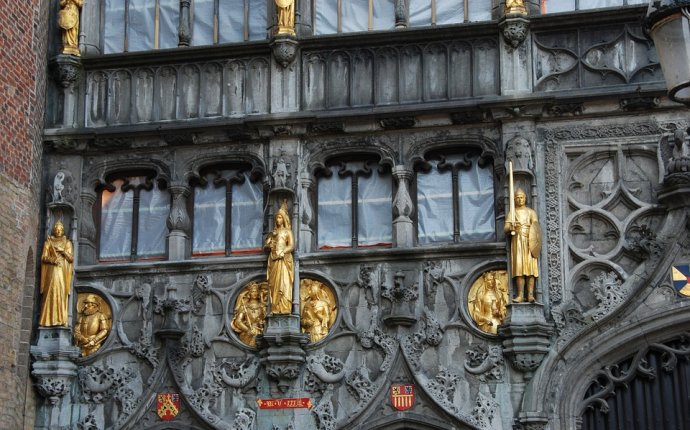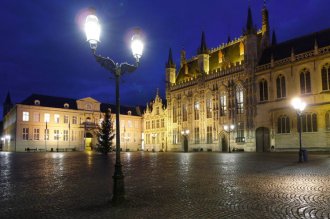
Bruges Belgium History

Le centre historique de Bruges
Bruges est un exemple exceptionnel d'habitat médiéval ayant bien conservé son tissu urbain historique tel qu'il a évolué avec les siècles et où le bâti gothique d'origine fait partie de l'identité de la ville. Bruges, l'une des capitales commerciales et culturelles européennes, a tissé des liens culturels avec différentes parties du monde. On associe cette cité à l'Ecole de peinture des Primitifs flamands.
وسط بروج التاريخي
تعطي مدينة بروج مثلاً إستثنائياً عن نمط السكن السائد في القرون الوسطى والذي حافظ جيداً على نسيجه الحضري التاريخي في تطوره عبر القرون بحيث أصبح البناء القوطي الأصلي جزءاً لا يتجزأ من هوية المدينة. وقد أرست بروج، التي تُعتبر إحدى العواصم التجارية والثقافية في أوروبا، علاقات ثقافية مع مناطق مختلفة من العالم. وغالباً ما تُربط هذه المدينة بمدرسة الرسم للفنانين الفلمنديين البدائيين.
source: UNESCO/ERI
Description is available under license CC-BY-SA IGO 3.0
布鲁日历史中心
布鲁日是中世纪人类聚落的杰出典范,虽历经数世纪沧桑,仍保留着大量历史建筑。在那里,早期哥特式建筑已经成为城市特征的一部分。作为欧洲商业与文化首都之一,布鲁日不断发展与世界各地的文化交流,同时,与佛兰芒原始绘画流派(Flemish Primitive painting)有着密切关系。
source: UNESCO/ERI
Description is available under license CC-BY-SA IGO 3.0
Исторический центр города Брюгге
Брюгге – это яркий пример средневекового поселения, которое хорошо сохранило свою многовековую историческую застройку, в которой подлинные готические строения представляют важнейшую часть своеобразия города. Как одна из торговых и культурных столиц Европы, Брюгге развивал культурные связи с различными районами мира. Город был тесно связан с формированием фламандской школы живописи.
source: UNESCO/ERI
Description is available under license CC-BY-SA IGO 3.0
Centro histórico de Brujas
La ciudad de Brujas es un ejemplo excepcional de asentamiento humano medieval que ha conservado su tejido urbano histórico tal como ha ido evolucionando a lo largo de los siglos. Sus construcciones góticas primigenias forman parte de la identidad de esta capital comercial y cultural de la antigua Europa, que estableció vínculos culturales con distintas partes del mundo. El nombre de Brujas está estrechamente unido a la escuela de pintura de los primitivos flamencos.
source: UNESCO/ERI
Description is available under license CC-BY-SA IGO 3.0
ブリュージュ歴史地区
Historisch centrum van Brugge
Brugge is een mooi voorbeeld van een middeleeuwse nederzetting die zijn historische vorm heeft behouden in de loop van de eeuwen, waarbij de oorspronkelijke, gotische constructies deel uitmaken van de identiteit van de stad. De historische binnenstad laat zien waardoor de architectuur beïnvloed werd. Zoals de baksteengotiek en innovatieve, artistieke invloeden van middeleeuwse schilderkunst zoals de Vlaamse Primitieven. Brugge geldt als de geboorteplaats van deze schilderschool waarvan kunstenaars als Jan van Eyck en Hans Memling deel uitmaken. Mede hierom werd Brugge een van de commerciële en culturele hoofdsteden van Europa met culturele banden over de hele wereld.
Historic Centre of Brugge (Belgium) © OUR PLACE The World Heritage CollectionOutstanding Universal Value
Brief synthesis
The Historic Centre of Brugge is an outstanding example of an architectural ensemble, illustrating significant stages in the commercial and cultural fields in medieval Europe.
Brugge in medieval times was known as a commercial metropolis in the heart of Europe.
The city reflects a considerable exchange of influences on the development of art and architecture, particularly in brick Gothic, which is characteristic of northern Europe and the Baltic. This architecture strongly determines the character of the historic centre of the city.
The 1th century city walls marked the boundaries of the medieval city. Although the walls themselves are lost today, they remain clearly visible, emphasized by the four surviving gates, the ramparts and one of the defence water towers. The medieval street pattern, with main roads leading towards the important public squares, has mostly been preserved, as well as the network of canals which, once used for mercantile traffic, played an important role in the development of the city.
In the 15th century, Brugge was the cradle of the Flemish Primitives and a centre of patronage and painting development for artists such as Jan van Eyck and Hans Memling. Many of their works were exported and influenced painting styles all over Europe. Exceptionally important collections have remained in the city until today.
Even after its economic and artistic peak at the end of the Middle Ages, building and urban development continued, although Brugge mostly missed the 19th-century industrial revolution. In the 18th and 19th centuries, many medieval parcels were joined to larger entities and new quarters were also developed. The most striking examples of large scale post-medieval interventions in the historic centre are the urbanization around Coupure (1751-1755), the Zand and the first railway station (1838), the Theatre quarter (1867), the Koningin Elisabethlaan and Gulden Vlieslaan (1897) and the creation of the Guido Gezelle-neighbourhood (1920-1930).
In the second half of the 20th century, some major changes occurred with Zilverpand (1976), the new Public Library (1975-1978), the new Palace of Justice and Kartuizerswijk (1980), Clarendam (1990) and Colettijnenhof (1997).
Brugge is characterized by a continuity reflected in the relative harmony of changes. As part of this continuity, the late 19th century renovation of facades introduced a Neo-Gothic style that is particular for Brugge. The Brugge ‘neo’ style of construction and its restoration philosophy became a subject of interest, study and inspiration.
Still an active, living city today, Brugge has preserved the architectural and urban structures which document the different phases of its development including the central Market Place with its belfry, the Béguinage, as well as the hospitals, the religious and commercial complexes and the historic urban fabric.
Criterion (ii): The Historic Centre of Brugge bears testimony to a considerable exchange of influences on the development of architecture, and particularly brick Gothic architecture, over a long period of time. As the birthplace of the school of the Flemish Primitives, it has favoured innovative artistic influences in the development of medieval painting.
Criterion (iv): The Historic Centre of Brugge is an outstanding example of an architectural ensemble. The city’s public, social and religious institutions illustrate significant stages in the history of commerce and culture in medieval Europe
Criterion (vi): The Historic Centre of Brugge was birthplace of the Flemish Primitives and a centre of patronage and development of painting in the Middle Ages with artists such as Jan van Eyck and Hans Memling.
Authenticity
The Historic Centre of Brugge illustrates continuity on an urban site that has been occupied since the early Middle Ages. Historical records of the town administration and regulations are condensed in the city records from the 13th century onwards.









